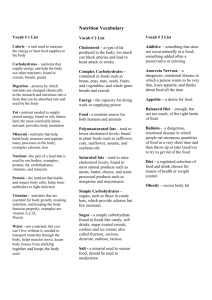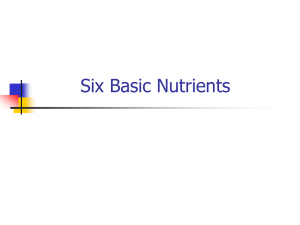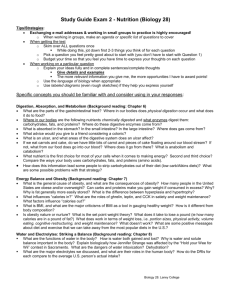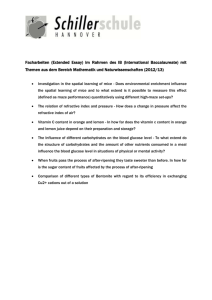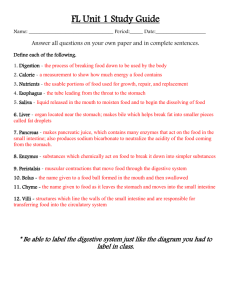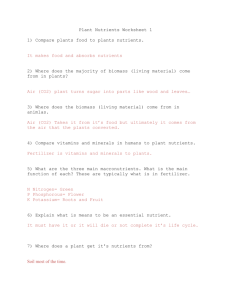List of Equipment, Tools, Supplies, and Facilities
advertisement
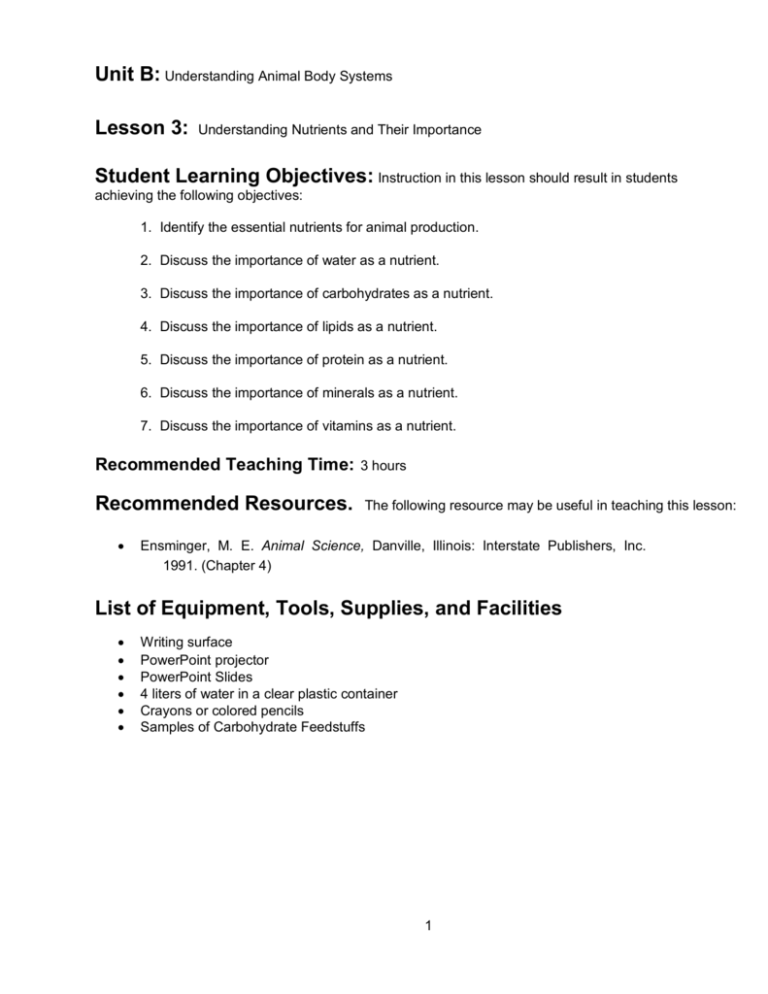
Unit B: Understanding Animal Body Systems Lesson 3: Understanding Nutrients and Their Importance Student Learning Objectives: Instruction in this lesson should result in students achieving the following objectives: 1. Identify the essential nutrients for animal production. 2. Discuss the importance of water as a nutrient. 3. Discuss the importance of carbohydrates as a nutrient. 4. Discuss the importance of lipids as a nutrient. 5. Discuss the importance of protein as a nutrient. 6. Discuss the importance of minerals as a nutrient. 7. Discuss the importance of vitamins as a nutrient. Recommended Teaching Time: Recommended Resources. • 3 hours The following resource may be useful in teaching this lesson: Ensminger, M. E. Animal Science, Danville, Illinois: Interstate Publishers, Inc. 1991. (Chapter 4) List of Equipment, Tools, Supplies, and Facilities • • • • • • Writing surface PowerPoint projector PowerPoint Slides 4 liters of water in a clear plastic container Crayons or colored pencils Samples of Carbohydrate Feedstuffs 1 Terms: The following terms are presented in this lesson (shown in bold italics) PowerPoint Slides 2 and 3: Balanced ration Carbohydrates Complex carbohydrates Disaccharides Essential nutrients Ether Fat Interest Approach: Macrominerals Microminerals Mineral Monosaccharides Nutrient Proteins Ration Ether Fat Fat Soluble Vitamins Fiber Lipid Ration Simple Carbohydrates Use an interest approach that will prepare the students for the lesson. Teachers often develop approaches for their unique class and student situations. A possible approach is included here. Ask the students "What do mothers feed their newborn babies?" When they answer, "Milk" ask them "Why do we give newborn babies milk?” When they answer “Because milk has all the nutrients or “right things” a baby needs.” Lead discussion into objective one of lesson that it is important that we give animals the "right" things to eat as well. Summary of Content and Teaching Strategies Objective 1: Identify the essential nutrients for animal production. Anticipated Problem: What are the essential nutrients for animal production? **Ask students to make a list of essential food items for humans to live. Have them turn to another student and share their list. Then, ask them to make a list of what they think animals need to survive. Have them turn to another student and share. Are these lists similar? Different? I. Proper animal nutrition is key to good livestock production. What happens if we don’t eat the right diet? Good nutrition can increase feed efficiency and the rate of gain for animals. Animals must be fed a diet that meets their needs. If these needs are not met properly, the animal won't grow, reproduce, or could possibly die. Feedstuffs contain nutrients. A nutrient is a substance that is necessary for an organism to live and grow. A ration is the total amount of feed an animal has in a 24hour period. The ration can be fed all at one time, or available at various points throughout the day. A balanced ration is one that contains all the nutrients that the animal needs in the correct proportions. Too much of any one nutrient is wasteful and could prove harmful to the animal. A nutrient deficiency can result in stunted growth and low production. Nutrients that are required for proper growth in all animals are called essential nutrients. There are six essential nutrients. They are: A. Water B. Carbohydrates C. Lipids or Fats D. Protein E. Minerals F. Vitamins **Have students write down their “ration” for the past day. What did they have to eat in the last 24 hours? Then ask them if this is properly balanced with all of the essential nutrients. If the answer is no, ask them to try to add foods that would balance their “ration.” Review why it is important to have a properly balanced diet. Also ask what would happen if we had too much or too little of something. Also, use PowerPoint Slides 4, 5, and 6 and TM: 3-1 to help students take notes. 2 **Tell students that they will be making a “Nutrient Notebook” as you talk about the 6 essential nutrients in an animal’s diet. Take 2 sheets of paper and fold them in half to create a “notebook.” Tell students to illustrate the cover using crayons or colored pencils. Then, each page will have information about 1 of the 6 essential nutrients. Remind students that they may be able to use this on a test later.** Objective 2: Discuss the importance of water as a nutrient. Anticipated Problem: What is the importance of water as a nutrient? II. Water is necessary for an animal's survival. Animals can live longer without food than without water. It makes up about 75 percent of the weight of a mature animal and as much as 90 percent of a newborn. How much is 75%? Take a 4 liter container of water and measure out 75% to show students how important water is. What would happen if animals did not have water? Water is found in every cell of the body. The amount of water needed by an animal is related to the activity the animal performs, and the stage of life of the animal (lactation, gestation, etc.). Water can enter into the body in many different ways. Most of it enters by drinking. Water is also found in the feed that animals consume and may be produced through biochemical reactions. Water may be lost from the body through urine, feces, sweat, and vapor from the lungs. Water that is taken in by an animal should be clean and fresh. Water should be available to animals at all times. Water has two main functions in an animal's body. (PowerPoint Slides 7, 8, and 9) A. One function of water is to regulate the animal's body temperature. Water helps control body temperature because it is able to accumulate, transfer, and lose heat through evaporation. B. Water also promotes biochemical processes in the animal. All biochemical reactions in the body require water. Water is a major component of cells, blood, and body tissues. Use PowerPoint Slide 10 to help students with note taking. Ask students to tell you 2 functions of water in the body. Make sure they have all information needed copied in the notebook. Also, have students create a story about a drop of water as it moves through an animal. What functions does water perform as it moves through the body? Objective 3: Discuss the importance of carbohydrates as a nutrient. Anticipated Problem: What is the importance of carbohydrates as a nutrient? Ask students how we get carbohydrates in our diet. How do animals get this nutrient? III. Carbohydrates are feed components that provide energy and are composed of carbon, hydrogen, and oxygen. They are a major component of plant tissues. Carbohydrates should make up about 75 percent of an animal's diet. They provide energy in a chemical reaction during digestion that is much like burning. This energy powers muscular movements. Carbohydrates also produce the body heat that helps to keep the animal warm. In addition to energy, carbohydrates aid in the use of proteins and fats by the body. Carbohydrates are not stored in the body. They must be provided in the animal's diet every day. Unused carbohydrates are converted into fat to be stored. (PowerPoint Slides 11, 12, and 13) A. There are three types of carbohydrates. They are: 1. Sugars—There are two kinds of sugars: simple sugars (monosaccharides) and double sugars (disaccharides). Glucose and fructose are simple sugars. Sucrose is a double sugar. Sucrose is what is used to make table sugar. Glucose is an excellent source of energy for most cells. 2. Starch—Starch is an important source of energy. Starch is converted to glucose in the digestive process. 3 3. Fiber—Fiber is the material left after the food has been digested. It is made of plant cells and cellulose. Fiber aids the digestive system to function properly. Fiber also absorbs water and provides bulk. It plays an important role in ruminant digestion by increasing bacterial populations in the rumen. PowerPoint Slides 14, 15, and 16 B. Carbohydrates may be classified as either simple carbohydrates or complex carbohydrates. 1. Simple carbohydrates are easily digested. Sugar and starch are simple carbohydrates. This type of carbohydrate is found in cereal grains such as maize, wheat, and barley. 2. Complex carbohydrates can also be called fiber. Cellulose and lignin are complex carbohydrates. These substances are more difficult to digest than simple carbohydrates. These are found mainly in roughages such as lucerne and clover. Have examples of simple and complex carbohydrates to show the class. Ask the class which type of carbohydrate would be the easiest to supply? Have them explain why? Make sure they have all information needed copied in their notebook. Also use PowerPoint Slides 17, 18, and 19. Objective 4: Discuss the importance of lipids as a nutrient. Anticipated Problem: What is the importance of lipids as a nutrient? IV. A lipid is a food component that provides energy and is also the form in which animals store energy. Most lipids are fats or oil. A fat is the solid form of a lipid. Fats contain the highest amounts of energy. They can contain 2.25 times more energy than carbohydrates. Fats play an important role in supplying the energy needed by an animal for normal body maintenance. A key role of fats is they are the only way the fat-soluble vitamins A, D, E, and K can enter the animal's body. Ask students to explain why it is important for animals to store energy? Then, why would it be important to have fats, or lipids, in an animal’s diet? Make sure they have all information needed copied in the notebook. Also use PowerPoint Slides 20 and 21. Objective 5: Discuss the importance of protein as a nutrient. Anticipated Problem: What is the importance of protein as a nutrient? V. Proteins are organic compounds primarily made up of amino acids. This nutrient is needed to grow new tissues and to repair old tissues in the animal. Three to five percent of the body's proteins are rebuilt every day. The highest amounts of protein can be found in the muscles of animals. Proteins can be classified as either essential or nonessential. Whether or not a protein is essential for proper growth depends on the digestive system of the animal. Sources of protein include cottonseed meal, fish meal, and alfalfa hay. Protein is the most common nutrient deficiency. Most feedstuffs are low in protein. Supplements may be needed. Symptoms of a protein deficiency include anorexia, slow growth rate, decreased feed efficiency, low birth weight, and lower milk production. Young animals need diets higher in protein than older animals. Animals in gestation or lactation stages also need higher levels of protein in their diets. 4 As a review, ask students where the most protein is found in animals. “Muscles” Then, ask students what should happen if an animal eats a lot of protein? The more protein they eat, the bigger their muscles should get. The bigger the animal’s muscles are, the stronger they are. This is important because animals help us work everyday. Also use PowerPoint Slides 22, 23, and 24 and TM: 3-2 to help in note taking. Objective 6: Discuss the importance of minerals as a nutrient. Anticipated Problem: What is the importance of minerals as a nutrient? VI. A mineral is an inorganic element found in small amounts in the body. Minerals are essential in skeleton growth and necessary for body systems to function properly. There are two groups of minerals. A. Macrominerals or major minerals are needed in the diet in relatively large amounts. This can range from a few tenths of a gram to one or more grams per day. The minerals included in this group include: 1. Salt (NaCl) [Sodium & Chorine] 2. Calcium (Ca) 3. Phosphorus (P) 4. Magnesium (Mg) 5. Potassium (K) 6. Sulfur (S) As a group have the students say out loud the six macrominerals. Repeat if necessary. Use PowerPoint Slides 25 and 26 and TM: 3-3 to help in note taking. B. Microminerals or trace minerals are minerals that are required in small quantities. These minerals are just as important as macrominerals, they are just needed in smaller quantities. This can range from a millionth of a gram to a thousandth of a gram per day. The minerals included in this group include: 1. Chromium (Cr) 2. Cobalt (Co) 3. Copper (Cu) 4. Fluorine (F) 5. Iodine (I) 6. Iron (Fe) 7. Manganese (Mn) 8. Molybdenum (Mo) 9. Selenium (Se) 10. Silicon (Si) 11. Zinc (Zn) Again, choose one student to lead the other students in saying all 11 microminerals out loud. As a review, discuss the differences between these two types of minerals. Also use PowerPoint Slide 27. 5 Objective 7: Discuss the importance of vitamins as a nutrient. Anticipated Problem: What is the importance of vitamins as a nutrient? VII. A vitamin is an organic substance needed in small quantities to perform specific functions. They do not provide energy, but are necessary in using energy. Vitamins aid the animals body by assisting to regulate body functions, keeping the body healthy, and developing resistance to diseases. The deficiency of a vitamin can lead to disease or death. Vitamins are in one of two groups. A. Fat-soluble vitamins are vitamins that are stored in the fat and released as they are needed by the body. These include vitamins A, D, E, and K. B. Water-soluble vitamins are vitamins that are dissolved by water and need to be consumed every day. They include vitamin C and the B vitamins. Distribute crayons to every student. Tell them they are going to make their own connections to each of the vitamins just discussed. On a sheet of paper, students will write/draw the word “Vitamin A” or D, E, K etc. For each vitamin they should use a different color. This color should represent the vitamin they are drawing. For example, vitamin K might be red because it is required for blood clotting. Also use PowerPoint Slides 28 and 29 and TM: 3-4 to help with notes. Review/Summary. Use the student learning objectives to summarize the lesson. Have students explain the content associated with each objective. Have students create flashcards to review this material. Flashcards can be made by cutting small squares of paper and putting a term on the front and the definition of that term on the back side of the card. Then, students can pair up and test each others knowledge. Evaluation. Focus the evaluation of student achievement on mastery of the objectives stated in the lesson. Measure student performance on classroom participation, assignments, and written tests or quizzes. A sample test is provided. Answers to Sample Test: Part One: Matching 1 = f, 2 = d, 3 = b, 4 = c, 5 = h, 6 = g, 7 = e, 8 = i, 9 = a, 10 = j Part Two: Completion 1. skeleton 2. glucose 3. 75 4. Water 5. Fats Part Three: Short Answer Water, Carbohydrates, Lipids (Fats), Protein, Minerals, Vitamins 6 Sample Test 3-1 Name_____________________________________ Test Part One: Matching Instructions. Match the term with the correct response. Write the letter of the term by the definition. a. d. g. i. Balanced ration Lipid Simple carbohydrates Fiber b. e. h. j. Carbohydrates Nutrient Vitamin Complex carbohydrates c. Essential nutrients f. Proteins _______ 1. Organic compounds made up of primarily amino acids. _______ 2. A food component that provides energy and is also the form in which animals store energy. _______ 3. Feed components that provide energy and are composed of carbon, hydrogen, and oxygen. _______ 4. Nutrients that are required for proper growth in all animals. _______ 5. An organic substance needed in small quantities to perform specific functions. _______ 6. Type of carbohydrate is found in cereal grains such as maize, wheat, and barley. _______ 7. A substance that is necessary for an organism to live and grow. _______ 8. Material left after the food has been digested. _______ 9. Contains all the nutrients that the animal needs in the correct proportions. _______ 10. Can also be called fiber. Part Two: Completion Instructions. Provide the word or words to complete the following statements. 1. Minerals are essential in ___________ growth and necessary for body systems to function properly. 2. Starch is converted to ____________ in the digestive process. 3. Carbohydrates should make up about _________ percent of an animal's diet. 7 4. ____________________ is found in every cell of the body. 5. ________________ can contain 2.25 times more energy than carbohydrates. Part Three: Short Answer Instructions. Provide information to answer the following question. What are the six essential nutrients? 8 TM: 3-1 ESSENTIAL NUTRIENTS Water Carbohydrates Lipids (Fats) Protein Minerals Vitamins 9 TM: 3-2 ESSENTIAL PROTEINS Poultry Ruminants Arginine Arginine Histidine Histidine Isoleucine Isoleucine Leucine Leucine Lysine Lysine Methionine Methionine Phenylalanine Phenylalanine Threonine Threonine Tryptophan Tryptophan Valine Valine Alanine Aspartic acid Glycine Serine *Part can be replaced with Cystine **Part can be replaced with Tyrosine 10 TM: 3-3 MINERAL NEEDS, FUNCTIONS, AND DEFICIENCY SYMPTOMS Macrominerals Calcium (Ca) Phosphorus (P) Function Deficiency Symptoms structural component of the skeleton; rickets or osteomalacia develop—the controls the excitability of nerves and bones become soft and deformed; milk muscles; required for coagulation of the fever occurs in cows; blood clotting time blood increases component of the skeleton providing rickets; depressed appetite; may chew on structural support; aids in lipid wood or other objects transport and metabolism; component of AMP, ADP, and ATP Magnesium (Mg) Potassium (K) needed for normal skeletal growth; anorexia; reduced weight gain; reduced needed in chemical reactions in muscles; magnesium in the blood; hyperemia of the activates enzymes during the Kreb cycle ears and other extremities required to move sodium; helps to slowed growth; unsteady walk; overall maintain acid-base balance in the body; muscle weakness; Mg deficiency causes K helps to uptake glucose and deficiency carbohydrates Sodium (Na) Chlorine (Cl) maintains osmotic pressure; maintains reduced rate of growth; reduced feed acid-base balance; required in efficiency; decreased milk production; transmission of nerve impulses weight loss in adults regulates extracellular osmotic pressure; slowed growth; fall forward with legs maintains acid-base balance in the body extended backward when startled by a sudden noise (Continued) 11 Macrominerals Function Deficiency Symptoms required for protein synthesis; used in Sulfur (S) cartilage; in birds S is used in feathers, reduced growth; reduced weight gain the lining of the gizzard, and in muscle Cobalt (Co) Iodine (I) loss of appetite; reduced growth; anemia; makes up vitamin B12 if untreated, death will result component of thyroxin—controls the Goiter—enlargement of the thyroid gland; oxidation of cells dry skin; brittle hair; young born without hair; reproductive problems activates enzymes; used in DNA and RNA slowed growth; anorexia; scaling and Zinc (Zn) cracking of paws; poor feathering; rough hair found in hemoglobin in the blood; found anemia—common problem among in myoglobin in muscle newborns; pale color; shallow breathing; Iron (Fe) rough hair; slow growth; iron deficiency affects about half of the world's human population enzyme activity to uptake iron; needed Copper (Cu) to maintain the central nervous system Manganese (Mn) needed in bone structure anemia; incoordination skeletal deformation—enlarged joints; lameness, shortening of legs, and bowing of the legs Selenium (Se) component of numerous enzymes nutritional muscular dystrophy 12 TM: 3-4 VITAMIN FUNCTIONS AND DEFICIENCY SYMPTOMS Fat Soluble Vitamins Function Deficiency Signs Vitamin A required in retinol for night vision; needed in epithelial cells, which cover body surfaces; needed for bone growth night blindness; dry and irritated eyes; respiratory infection; reproductive problems Vitamin D enhanced CA and P levels allowing bone mineralization; prevents tetany abnormal skeletal development—lameness, bowed, and crooked legs; slowed growth failure of the reproductive Vitamin E Vitamin K Thiamin (B1) promotes health system; changed cell permeability; muscular lesions required for blood clotting long blood clot time; promotes health anorexia, beriberi in humans— hemorrhages; in severe cases, death numbness, weakness, and stiffness in thighs, unsteady walk, edema in feet and legs, and pain along the spine (Continued) 13 Fat Soluble Vitamins Function Deficiency Signs Riboflavin (B2) functions in reduced growth rate; skin lesions; hair loss coenzymes Niacin retarded growth; decreased appetite; diarrhea; vomiting; dermatitis used by cells in energy metabolism slowed growth; dermatitis; graying of the hair; fetal death; skin lesions Pantothenic Acid needed in energy metabolism Vitamin B6 help with protein and nitrogen convulsions; lesions around feet, face, and ears metabolism; involved in formation of red blood cells Vitamin B12 needed in several enzyme systems anemia*; retardation; skin pigmentation Folacin used in a variety of metabolic slow growth rate; anemia reactions Biotin Choline needed for several enzyme systems scaly skin; abnormalities of aids in transmission of nerve fatty liver; hemorrhaging kidney impulses the circulatory system Ascorbic prevents scurvy; causes several scurvy—edema, weight loss, Acid metabolic reactions to occur and diarrhea *This can occur in monogastrics fed entirely from plant material. Babies nursing from vegetarian mothers may also develop a vitamin B12 deficiency. 14



